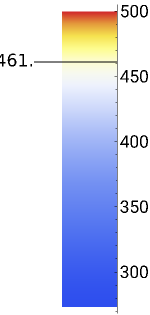Heat Transfer in Fins
Heat Transfer in Fins
This Demonstration calculates the heat transfer rate through a single fin (either a rectangular or a pin fin) mounted on a heat sink at 500 K. Air flows laminarly across the fin in the direction indicted by the arrows in the figure (rotate the fin with a mouse to help visualize the flow pattern). The fin tip is adiabatic. Use sliders to vary the fin length and the air temperature. Select the fin material from the drop-down menu. The temperature distribution is shown on the fin surface using a color scale (red is hottest, blue is coolest), and the temperature of the fin tip is shown on the scale. Both the rectangular fin thickness and the pin fin diameter are 1.5 mm. The heat transfer rate through the fin is displayed above the fin, as is the fin effectiveness, which is the ratio of the fin heat transfer rate to the heat transfer rate without the fin.
Details
Details
The heat transfer coefficient of air is calculated using Nusselt correlations for laminar flow over a flat plate and a cylinder. Air properties are evaluated at 300 K. The average Nusselt and Reynold's numbers are:
h
Nu
rect
hw
k
a
Re
rect
uw
ν
w
Nu
pin
ht
k
a
Re
pin
ut
ν
t
and is the thermal conductivity of air (W/[m K]), is the velocity of air (m/s), is the kinematic viscosity of air (/s) and is in units of .
k
a
u
ν
2
m
h
W/[K]
2
m
For a rectangular fin:
Nu
rect
1/2
Re
rect
1/3
Pr
for a pin fin:
Nu
pin
0.466
Re
pin
1/3
Pr
and is the unitless Prandtl number:
Pr
Pr=
Cpμ
k
a
where is the heat capacity of air (J/[kg K]), and is the dynamic viscosity of air ().
Cp
μ
[Ns]/
2
m
For a fin with a tip that is assumed to be adiabatic:
T=+(-)
T
∞
cosh(m(L-z))
cosh(mL)
T
b
T
∞
q=-)
hPkA
tanh(mL)(T
b
T
∞
where is temperature (K), is the ambient air temperature, =500K is the base temperature, is a simplification term, is the fin length (m), is distance down the fin, is the fin heat transfer rate (W), is the fin perimeter (m), is the fin cross-section area () and is the thermal conductivity of the material (W/[m K]), and .
T
T
∞
T
b
m
L
z
q
P
A
2
m
k
m=
hP
kA
For a rectangular fin:
P=2w+2t
A=wt
For a pin fin:
P=πt
A=
π
4
2
t
The fin effectiveness is the ratio of the fin heat transfer rate to the heat transfer rate that would exist without the fin:
ϵ
ϵ=
q
hA(-)
T
b
T
∞
The thermal conductivities (W/[m K]) of the fin materials are:
stainless steel
k=14
carbon steel
k=60.5
iron
k=80.2
brass
k=110
aluminum
k=237
copper
k=401
References
References
[1] T. L. Bergman, A. S. Lavine, F. P. Incropera and D. P. DeWitt, Introduction to Heat Transfer, 6th ed., Hoboken, NJ: John Wiley & Sons, 2011.
External Links
External Links
Permanent Citation
Permanent Citation
Rachael L. Baumann, John L. Falconer
"Heat Transfer in Fins"
http://demonstrations.wolfram.com/HeatTransferInFins/
Wolfram Demonstrations Project
Published: September 26, 2016
